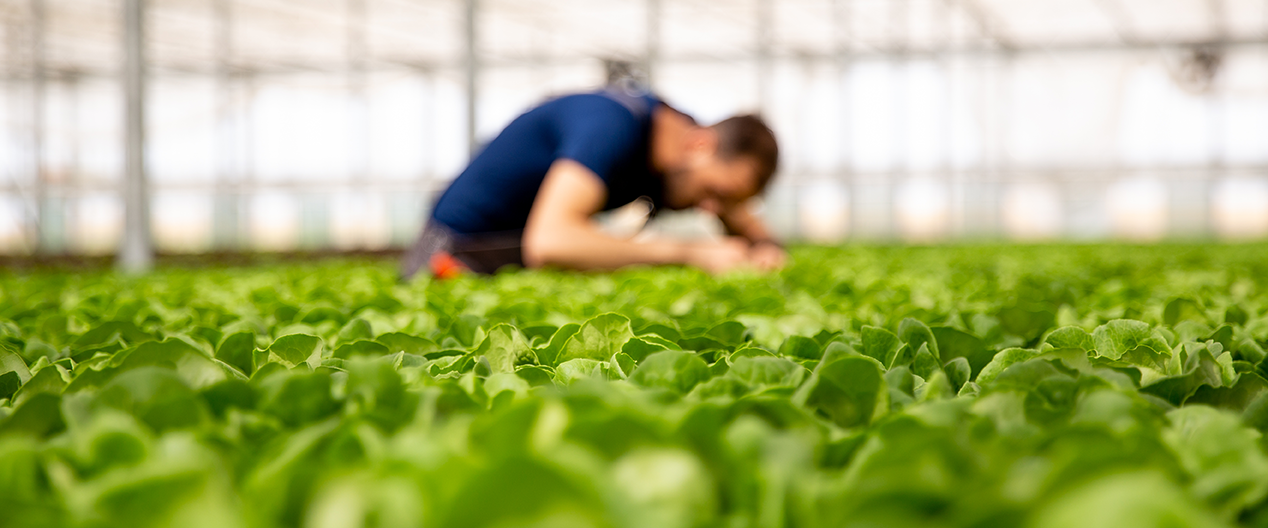
Engineered Nanoparticles Target Specific Structures on Plant Leaves
The United Nations’ Food and Agriculture Organization predicts that by 2050, the world population will have reached almost 10 billion people, increasing global food demand by 70 percent. With little prospect for new agricultural land and increasing pressure to decrease environmental impact, current agricultural techniques will not be able to support human demands.
CEE Professor Greg Lowry is creating nanoparticle (NP) coatings that will revolutionize the agricultural industry. His research has demonstrated that molecules, such as vital nutrients, coated with his team’s NPs can be applied to plants with 99 percent uptake efficiency. This is in stark contrast to current methods of delivery, in which as little as one percent of the desired molecules will actually enter the plant—the other 99 percent will drain into the surrounding environment.
Now Lowry and his team have demonstrated for the first time the ability of engineered NPs to target specific structures on plant leaves. Their latest research, published in Nanoscale Communications, showed that molecules could be delivered to stomata (pores) on the leaf’s surface by coating them with NPs with an affinity to those structures. This research mirrors similar efforts to treat specific areas within the human body using targeted medication.
The ability to target stomata on a plant leaf is an incredible breakthrough for the agricultural industry. Not only could this allow farmers to deliver nutrients or pesticides directly to where they’re needed, but it could also lead to a major reduction in the roughly four million tons of pesticides applied yearly.
In their research, Lowry’s team coated gold nanoparticles (AuNP) with different types of coatings: non-targeting citrate or LM6-M, an antibody with an affinity for functional groups unique to stomata on leaf surfaces. They then immersed leaves of the Vicia faba (fava bean) plant in one of the AuNP solutions, allowing it to soak for two minutes before rinsing in cold water. Finally, images were taken at Brookhaven National Laboratory using dark field microscopy and synchrotron x-ray fluorescence mapping, revealing where the AuNPs had been transported.

As hypothesized, the LM6-M coated AuNPs were found to have collected on and around the stomatal guard cells, a pair of large cells that control entry into the plant through the stomata. Alternatively, the non-targeting citrate AuNPs were dispersed randomly across the leaf surface. In this way, the researchers were able to show for the first time that live leaf structures had been actively targeted using NPs coated with biomolecular recognition molecules.
The greatest potential for nanoparticle targeting may be in pesticide application. Once a pathogen penetrates a plant’s defenses, often through the stomata, there is little that can be done to save it. The current solution is to douse the entire plant in pesticides in an attempt to kill any dangerous microbe in its immediate environment before it may enter the plant; yet 20 to 40 percent of potential agricultural productivity is still lost to pathogens.
By reducing this number, Lowry’s NPs could help the agricultural industry save billions. Antimicrobial nanoparticles targeted toward stomata and other common pathogen entry points could intercept these invaders before they have a chance to enter the plant. This increases the likelihood of pesticide contacting pathogen, and could greatly decrease the overall amount of pesticides necessary.
Lowry and his fellow researchers are continuing to explore other opportunities presented by their novel method of targeted NP delivery. NPs made from important micronutrients or polymeric nano-carriers could guide nutrients and pesticides to other plant structures desirable for crop nourishment or protection. In another medical parallel, they’re also interested in exploring whether NPs could be delivered into a plant through the leaves in applications similar to inoculation. These could then lie dormant until triggered by environmental stress to release their lifesaving contents.
The potential for future applications only adds to the impressive abilities Lowry’s NPs have demonstrated. The incredible efficiency and pinpoint targeting of these nanoparticle coatings will be essential for meeting the environmental challenges and agricultural demands of the future.
Story originally published by CMU College of Engineering